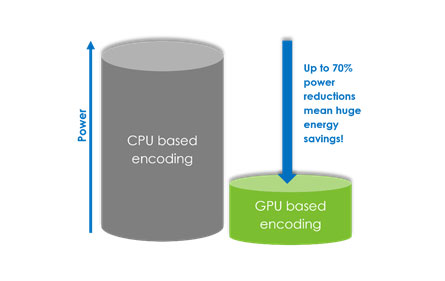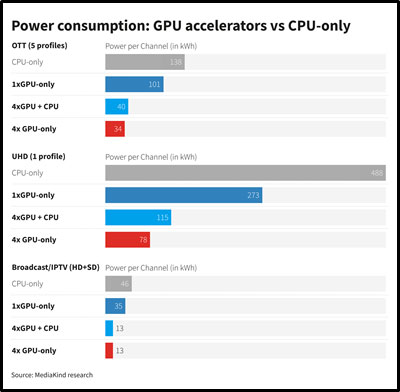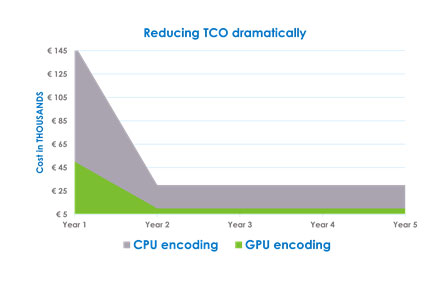The novel GPU-based video processing solution from MediaKind is set to be a triple win for businesses – providing significant reduction in operating expenses, cutting energy consumption by a major chunk and reducing capital expenditure, all the while improving high standards in key criteria including rack density, seamless ease-of-use, while maintaining superior picture quality. The latest innovation is part of our relentless drive to achieve the highest ESG benchmarks in the industry, and help customers in reducing their carbon footprint.
GPU vs. CPU
Video encoding is an extremely power-hungry function, requires as much as one-third of the computing capacity in the average datacenter being consumed during its processing. Balancing quality performance whilst keeping costs and CO2 emissions in check has so far proved to be a major challenge for the industry. MediaKind is tackling this issue head-on: optimising energy usage and reducing emissions during the video streaming process, thereby enabling considerably ‘greener’ video. Tests have shown that it has managed to free up the server’s main CPU(s) for more generic workloads and deliver up to an average of 70% energy savings compared to CPU-based encoding.

Three separate scenarios were tested for efficiency, with three different profile sets: The HD OTT scenario was made up of five different resolutions, 60 and 30 frames per second (fps) rates, and H.264 codecs. Bitrates ranged from 200kbps for 320×180 to 5Mbps for 1920x1080HD. The UHD OTT profile had a frame rate of 60 fps and HEVC codec at 16Mbps, and the broadcast/IPTV profiles with two resolutions – HD at 7.5Mbps, and SD 2.5Mbps MPEG-2, at 30fps
- Scenario 1: CPU vs, GPU for HD OTT with 5 profiles
Running with a CPU only model required 4 standard servers to handle the 16 HD channels with their associated profiles. When the GPU based solution was used (including the servers CPU capability), the server count fell to just one server. This meant a drop in the average power consumption per channel from 138W to 40w a 71% reduction.
- Scenario 2: CPU vs, GPU for UHD with 1 profile
In this scenario, each UHD channel typically requires a whole server to encode one channel. However with the GPU solution installed, the same server could then manage 5 channels. The power consumption per channel therefore dropped 76% (488w vs 115w)
- Scenario 3: CPU vs, GPU for Broadcast (2 profiles)
Finally, running a broadcast HD and SD version of the same services in a single server delivered 12 channels per unit, a huge 48 channels HD AND SD channels could be ran in one server with the GPU cards added – with power use per channel 71% lower by comparison.

Test results comparing a 48-channel CPU-only deployment vis-à-vis a GPU-based server deployment were found to reduce the total cost of ownership (TCO) metric by up to $200,000 over five years. Results also found the technology achieves reductions of about 65% for the encoding servers, making it ideal for businesses looking to optimise their data centre infrastructure. By using less power – by an average of almost 75% vs CPU-only in each scenario – the equivalent power per channel metric was as low as 13W for an IPTV HD channel (30FPS) and 78W for a UHD OTT profile (60FPS) – it reduces cooling requirements and associated costs as well. The carbon dioxide saved versus the CPU-only version was also an average 54 tonnes across the three GPU-accelerator combinations tested.


MediaKind’s GPU-based solution fully supports the H.264 and HEVC codecs and does not require any complex implementation for customers to deploy it. Customers can also choose to bring their own servers, so there is no reliance on bespoke hardware. The solution can be deployed on their own servers and the channels can be managed from the same user-friendly MediaKind interface with the same licensing model.
By consuming considerably less power and providing consistently higher levels of output compared to its peers, MediaKind clearly sets itself apart as the most viable option in a highly competitive industry with a compelling business case for its customers.
Read more about our G8 server with SG1 and other card options here: https://www.mediakind.com/wp-content/uploads/2020/10/G8-Datasheet.pdf and our Aquila Streaming and Broadcast solutions.



